![]()
![]()
![]()
Use LEFT and RIGHT arrow keys to navigate between flashcards;
Use UP and DOWN arrow keys to flip the card;
H to show hint;
A reads text to speech;
46 Cards in this Set
- Front
- Back
- 3rd side (hint)
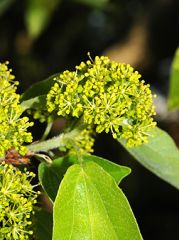
Acer buergerianum
|
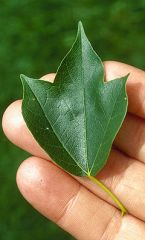
trident maple
|
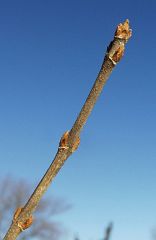
duck-foot leaf shape
exfoliating orange tinted bark opposite, 3-lobed, 1.5" to 3" long leaf base rounded, lobes point forward, looks like a duck foot leaf shape varies considerably on different individuals shiny, bright green when mature, emerge with reddish tints |
|
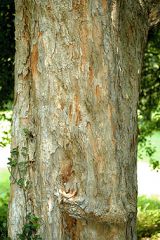
Acer buergerianum
|
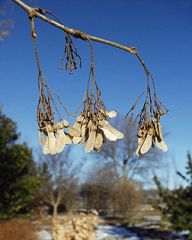
trident maple
|
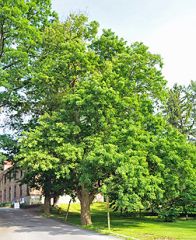
Trident maple (also commonly called three-toothed maple) is native to China, Korea and Japan. It is a small, rounded, deciduous tree that typically grows rather slowly to 20-30’. Triangular, three-lobed leaves (to 3.5” long) are glossy green above and pale green beneath. Variable but usually attractive fall color features shades of dark red and orange. Non-showy, greenish-yellow flowers bloom in spring (April-May). Samaras (to 1” long) mature in fall. Exfoliating bark will develop on mature trunks. Species name honors Heinrich Buerger, 19th century German botanist.
|
|
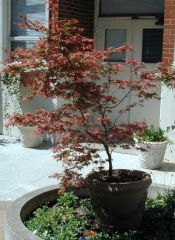
Acer palmatum
|
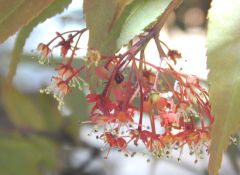
Japanese maple
|
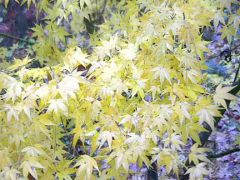
FLOWERS: Small red to purple flowers in spring. Borne in umbels or corymbs. Hard to see unless you look very closely.
FRUIT: Double samara that is small and red. Much smaller than the other maples. |
|
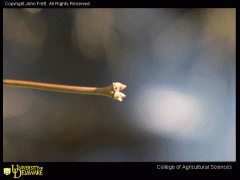
Acer palmatum
|
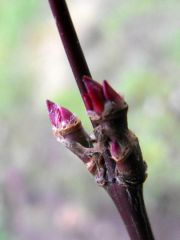
Japanese maple
|
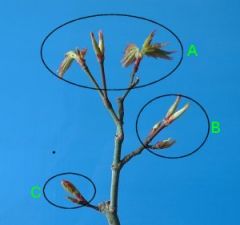
|
|
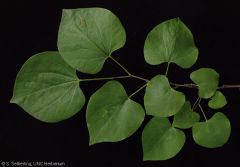
Cercis canadensis
|
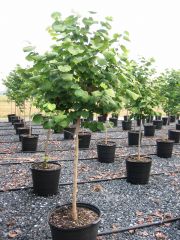
eastern redbud
|
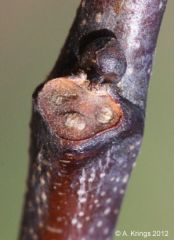
merging bronzed to medium green, slowly turning to dark green, and about 4" long and 4" wide
alternate, broad ovate leaves have distinctly cordate bases, overall yielding heart-shaped foliage with prominent palmate veination fall color is often chartreuse and ornamentally ineffectivezig-zag stems are lenticeled and dark brown (sometimes with subtle shades of purple or red in the stem color) vegetative lateral buds are small and purple-brown, while floral buds are slightly more plump and in clusters along stems, branches, and trunks terminal vegetative bud is absent flattened green pods change to brown pods containing small black seeds, in clusters on the twigs dried fruits may persist for over one year, but heavy fruit crops do not occur every year heart-shaped leaves occur on the new growth of zig-zag stems, while floral buds occur primarily on second-year wood but can arise from any branches and trunks of the tree, opening to lavendar-pink blossoms in early Spring before the foliage; ornamental orange-brown bark occurs with age, as the tree transitions from a juvenile vase shape to one that is rounded or irregular and leaning small, clustered, sessile dark brown floral buds swell to purple-lavender buds in early Spring, slowly opening to pink-lavender flowers, prominently displayed in April before the foliage emerges and persistent for two to three weeks flowers may be directly on the trunk or branches, but most are on two-year-old wood |
|

Cercis canadensis
|
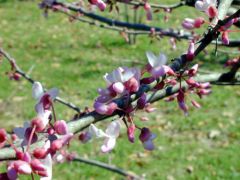
eastern redbud
|
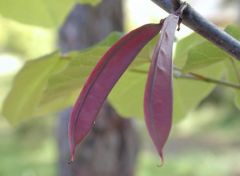
Pink flowers before the leaves in March. Will flower up and down branches. Many zygomorphic flowers per tree.Alternate and cordate shaped with 7 palmate veins. Petiole is light red and swollen at leaf blade. Up to 4" long
|
|
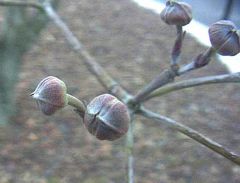
Cornus florida
|
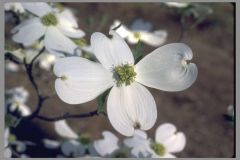
flowering dogwood
|
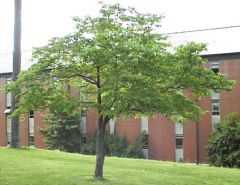
Yellow with 4 very showy white bracts before the leaves in March-April. Bracts form a cross. Flower buds are set in September for spring flowering.Attractive red drupes in the fall.
|
|
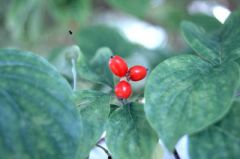
Cornus florida
|
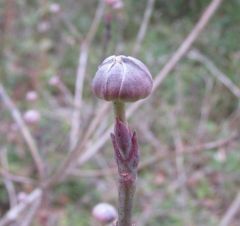
flowering dogwood
|
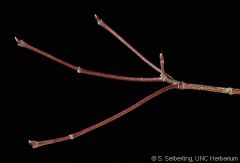
|
|
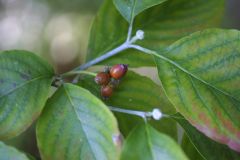
Cornus florida
|
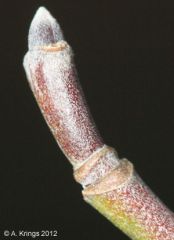
flowering dogwood
|
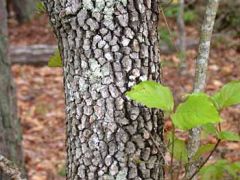
|
|
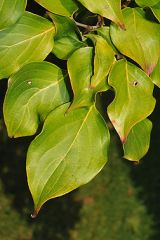
Cornus kousa
|
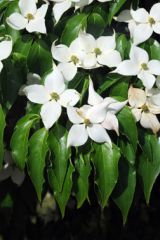
kousa dogwood
|
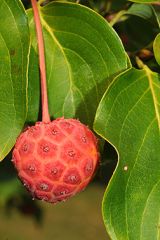
a small, vase-shaped tree with horizontal branching
mottled exfoliating bark pointed bract tips in comparison to the rounded bract tips of C. florida blooms about 2 or 3 weeks after C. florida red, raspberry-like fruits flower buds pointed and shaped like and onion |
|
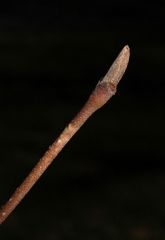
Cornus kousa
|
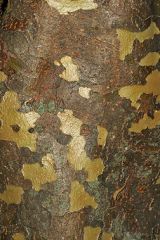
kousa dogwood
|

Leaf: Opposite, simple, oval to ovate with an entire margin, arcuate venation, 2 1/2 to 4 inches long, 2 to 2 1/2 inches wide, shiny dark green above, paler below with some tufts of golden-brown hair present particularly at base of petiole.
Flower: Monoecious; white to slightly yellow-white bracts surround a cluster of small inconspicuous flowers; white bracts are very showy, 2 to 3 inches across and often cover the entire plant in late spring (after flowering dogwood). Fruit: Very unusual, edible drupe, light red to pink in color, round and 1 to 1 1/2 inches across; yellowish orange inside and contains stony pits, borne on a 1 1/2 to 2 inch stalk, ripen in late summer to early fall. Twig: Slender, with initially some purple or green but later turning light brown; leaf buds resemble a cat claw, flower buds are considerably larger and heart-shaped. Bark: Initially smooth and light brown, later exfoliating into small patches forming a tan and brown cam |
|
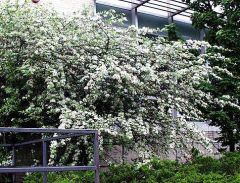
Crataegus crusgalli
|

cockspur hawthorn
|
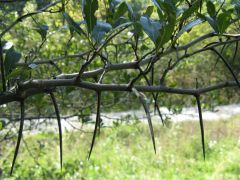
It may be seen as a dense, low-branched, broad-rounded tree to 25-35’ with horizontal branching armed with numerous large thorns (1.5-3” long). Lower branches often sweep near to the ground. It is also often seen as a tall, flat-topped shrub. Obovate to oblong-obovate dark green leaves (to 3” long) have wedge-shaped bases. Foliage turns orange to scarlet to purple red in fall. White flowers (in corymbs to 3”) bloom in May for a period of 7-10 days. Flowers emit an unpleasant fragrance. Flowers are followed by rounded fruits (3/8” diameter) that ripen in September-October and typically persist to late fall. Fruits are technically edible, but are usually best left for the birds. The fruit is sometimes called a haw. Crus-galli in Latin means leg of a cock in reference to the purported resemblance of the thorns of this plant to a cock’s spurs.
|
|
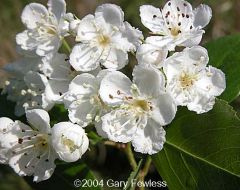
Crataegus crusgalli
|

cockspur hawthorn
|

|
|
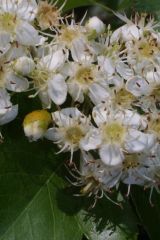
Crataegus phaenopyrum
|
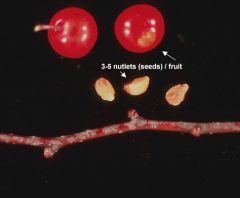
Washington hawthorn
|

1" to 3" long thorns along stems
a medium-sized deciduous tree 25' to 30' tall and 20' to 25' wide broad, rounded tree simple, lobed leaves |
|
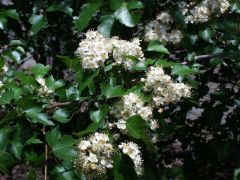
Crataegus phaenopyrum
|
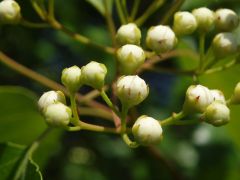
Washington hawthorn
|
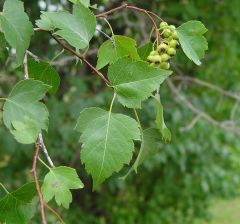
|
|
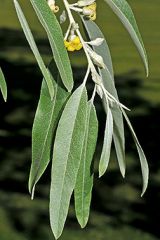
Elaeagnus angustifolia
|
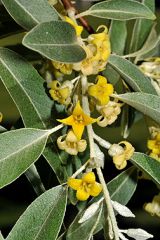
Russian olive
|
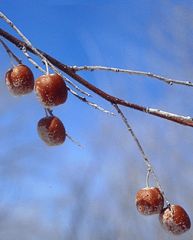
small, sessile, solitary, conical buds
suckers / invasive alternate leaf arrangement brown lenticels cover every part of plant silvery look to foliage, fruit and flowers yellow fruit |
|

Elaeagnus angustifolia
|
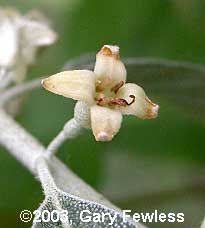
Russian olive
|
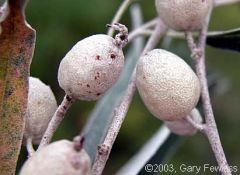
|
|
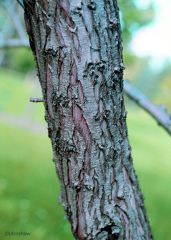
Elaeagnus angustifolia
|
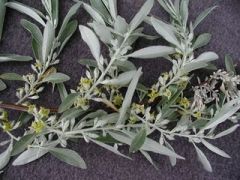
Russian olive
|
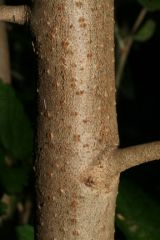
|
|

Koelreuteria paniculata
|
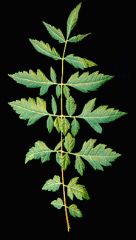
golden rain tree
|

sparsely branches medium-sized tree of rounded outline
yellow flowers in mid-summer inflated fruits twigs brownish with conspicuous lenticels buds are prominent, looking like Hershey's Kisses with a tuft of hair at the top |
|
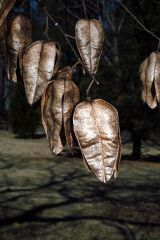
Koelreuteria paniculata
|

golden rain tree
|
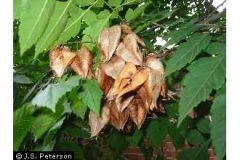
|
|
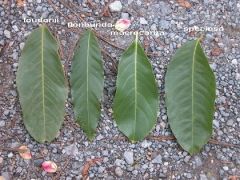
Lagerstroemia spp. and hybrids
|
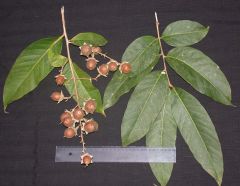
crape myrtle
|
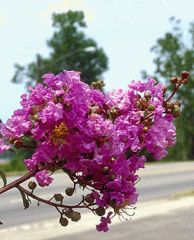
Leaf subopposite, elliptical to obvate, entire, square new stems, leaf tip may be emarginate with indica accumulate typical with faurei
|
|
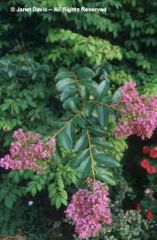
Lagerstroemia spp. and hybrids
|

crape myrtle
|
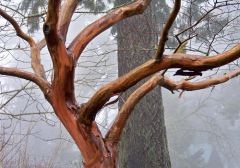
|
|
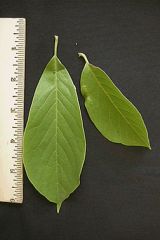
Magnolia x soulangiana
|
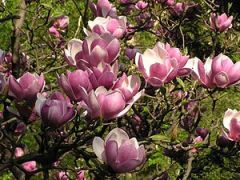
saucer magnolia
|
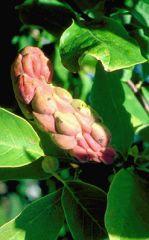
Leaf: Alternate, simple, oblong to obovate, 3 to 6 inches long, entire margin, green above, paler and fuzzy below.
Flower: Monoecious; large (4 to 8 inches) and showy, light pink to nearly purple petals, appearing in mid-spring. Fruit: A cone-like aggregate of follicles, 2 to 3 inches long; matures in late summer. Twig: Moderate, gray-brown, glabrous; buds tan and very fuzzy, flower buds quite large (nearly an inch); stipule scar encircles twig. Bark: Smooth, mottled gray. Form: Small tree to 20 feet, typically multi-stemmed with a narrow crown. |
|
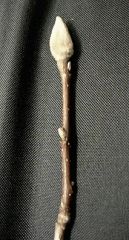
Magnolia x soulangiana
|
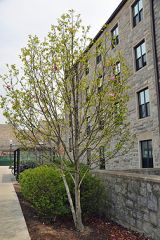
saucer magnolia
|
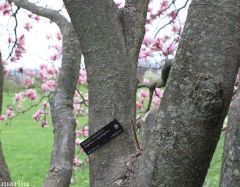
|
|
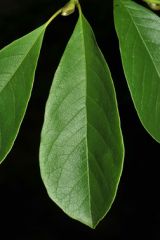
Magnolia stellata
|
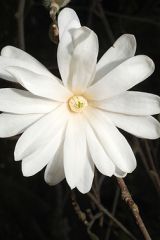
star magnolia
|
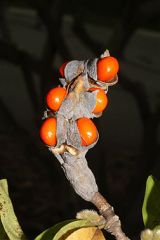
small leaves for a magnolia
flower buds covered with very long hairs 12 to 18 strap-like tepals per flower small habit and size for a magnolia |
|
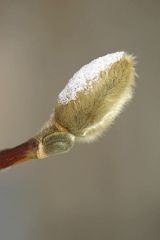
Magnolia stellata
|
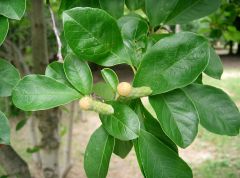
star magnolia
|
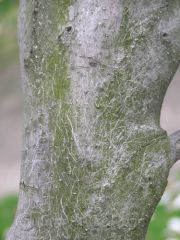
|
|

Malus spp.
|
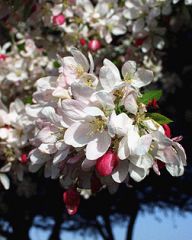
crabapple
|
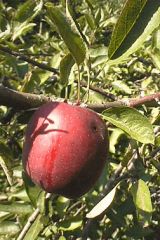
Leaf: Alternate, simple, elliptical to ovate, 1 1/2 to 3 inches, pinnately veined, finely serrated, sometimes borne on spur shoots, green above and paler, white pubescent below and on the petiole.
Flower: Perfect, showy, may be white to red in color, with 5 petals for each flower; appear in the spring, usually in umbels. Fruit: Pomes of various sizes and color (cultivar dependent) ranging from yellow to red when ripe in the fall. Twig: Moderate in thickness, brown to gray, rapid growth usually gray hairy, generally many spur shoots; buds plump ovate, gray hairy. Bark: Variable, generally smooth when young, later thin and scaly. Form: Generally poor, with twisted trunks and low branching; spur shoots are prominent. When unpruned, numerous sucker shoots form along trunk and in crown. |
|
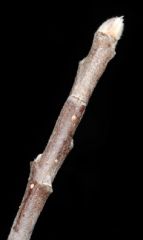
Malus spp.
|
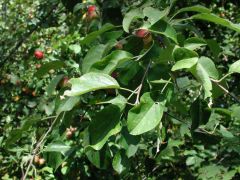
crabapple
|
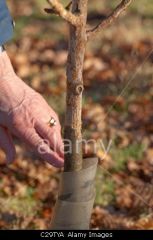
|
|
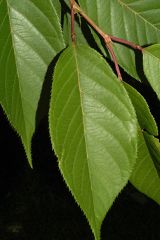
Prunus serrulata 'Kwanzan'
|

Kwanzan cherry
|
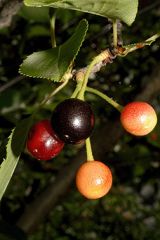
Leaf: Alternate, simple, pinnately veined, serrated margin, lanceolate to broadly ovate, 3 to 5 inches long, shiny dark green above, light green below, petioles have obvious glands.
Flower: Very showy, most commonly deep pink, double, occur in large clumps along the stem, in early spring. Fruit: Typically no fruit since the 'Kwanzan' variety is sterile, the species P. serrulata produces a small red cherry. Twig: Stout, reddish brown, conspicuous lenticels, and large reddish buds. Bark: Thin, smooth, reddish to bronze, glossy with very prominent horizontal lenticels. Form: A small tree reaching 25 to 30 feet high and wide, usually a vase-shaped, spreading crown. |
|

Prunus serrulata 'Kwanzan'
|
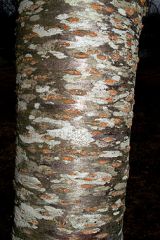
Kwanzan cherry
|
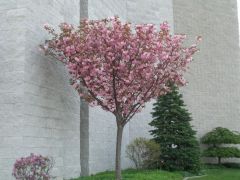
|
|
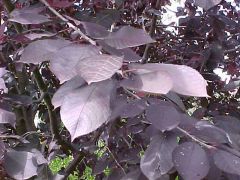
Prunus virginiana 'Schubert'
|
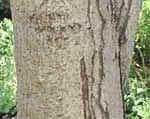
Schubert chokecherry; Canadian red cherry
|
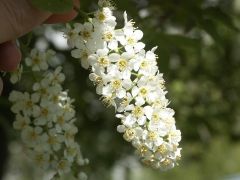
This chokecherry cultivar (sometimes called purpleleaf chokecherry) is a deciduous, suckering tree or shrub with a pyramidal habit which grows 20-30' tall. 'Schubert' is best known for its purple foliage: elliptic to obovate leaves (to 5" long) emerge green in spring, gradually maturing to dark purple by early summer. White flowers in racemes in spring give way in summer to clusters of reddish fruit (1/3" diameter cherries) which mature in fall to a dark purple. Fruit is very astringent, hence the common name. Fruit may be used in sauces, jellies and preserves, however. Fruits are attractive to wildlife.
|
|
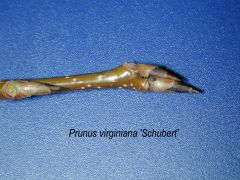
Prunus virginiana 'Schubert'
|
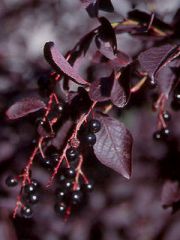
Schubert chokecherry; Canadian red cherry
|

|
|

Prunus x yedoensis
|
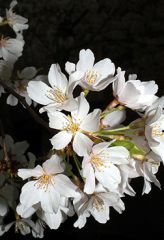
Yoshino cherry
|

Leaf: Alternate, simple, elliptical, 2 to 4 inches long, finely serrated, shiny dark green and smooth above, veins on underside pubescent, glands on the petiole.
Flower: Very showy, small but very numerous, clustered in groups of 4 or more, pink to white, appearing in early spring before the leaves. Fruit: Round drupe, 1/2 inch across, black when ripe. Twig: Slender, reddish brown; buds darker reddish brown, tall and pointed. Bark: Smooth, reddish gray, with large horizontal lenticels. Form: A small, wide spreading tree reaching 20 to 30 feet in height. |
|
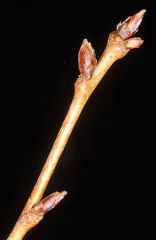
Prunus x yedoensis
|
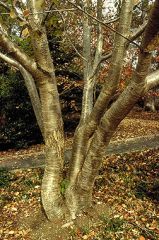
Yoshino cherry
|
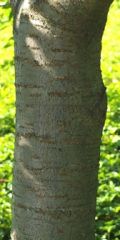
|
|
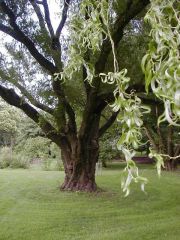
Salix matsudana 'Tortuosa'
|
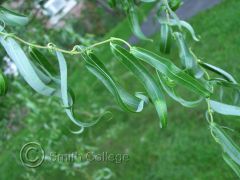
corkscrew willow
|
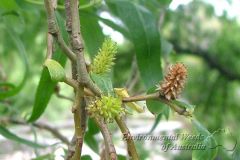
‘Tortuosa’, commonly called dragon’s claw willow, is an upright female clone that typically grows 20-30’ tall and 10-15’ wide. As the common name and cultivar name both suggest, this tree is most noted for its twisted and contorted branches, branchlets and leaves, and it is primarily grown to display this unusual growth. The contorted branching is most easily observed in winter after leaf drop. Small, non-showy, pale yellow female catkins appear in April-May. Lance-shaped leaves (to 4” long) are curled and twisted. Leaves are bright green above and whitish-green below. Fall color may be a respectable golden yellow. Rough, brown, fissured bark appears on mature trees. Native to China and northeast Asia, Salix matsudana is commonly called peking willow or hankow willow. It is a deciduous tree that grows to 40-50’ tall with an oval-rounded crown. Aside from its non-weeping form, it is otherwise very similar to S. babylonica. It should be further noted that Salix matsudana ‘Tortuosa’ is synonymous with and sometimes sold as Salix babylonica var. pekinensis ‘Tortuosa’. Additional common names for ‘Tortuosa’ include corkscrew willow, rattlesnake willow and contorted willow.
|
|

Salix matsudana 'Tortuosa'
|
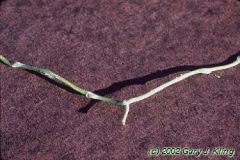
corkscrew willow
|
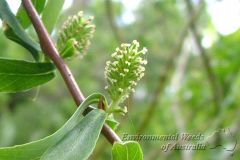
|
|
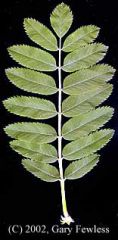
Sorbus aucuparia
|
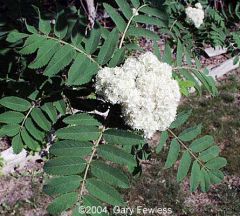
European mountainash; common mountain ash
|
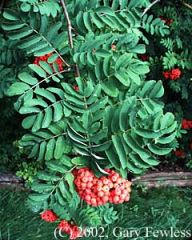
very large terminal buds
smooth bark short main trunk dividing into multiple trunks upright oval branching pinnately compound leaves a dark band is beneath each leaf scar white flowers in flat clusters orange red fruit in terminal clusters |
|
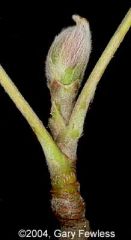
Sorbus aucuparia
|
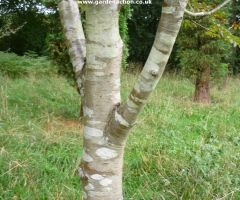
European mountainash; common mountain ash
|

Native to Europe and Asia, European mountain ash has been widely planted in northern North America as an ornamental and has naturalized in some parts of Canada and the northern U.S. It is primarily cultivated for its compound green leaves and attractive clusters of fall fruit. It is a small, deciduous tree that grows to 20-40’ tall with a narrow, upright-oval crown, usually rounding and opening with age. Compound, odd-pinnate, flat medium green leaves have 9-15 serrate, oblong-lanceolate leaflets (each leaflet to 2.5” long). Leaves turn yellow to reddish-purple in fall. Small, white, 5-petaled flowers (1/3” across) bloom in flattened corymbs in May. Flowers give way to pendant clusters of orange-red berry-like drupes in late summer. Cultivars are available in commerce featuring pink, yellow and bright red fruits. Mountain ashes have ash-like leaves, but are members of the rose family, and are not related to true ashes (Fraxinus of the olive family).
|
|
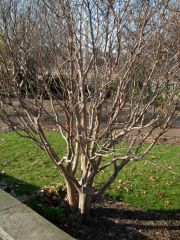
Stewartia pseudocamellia
|
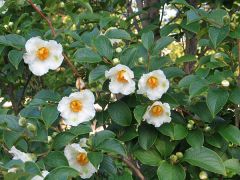
Japanese stewartia
|
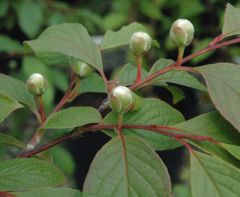
Japanese stewartia is a small, slow-growing, pyramidal, deciduous tree which typically matures over time to 20-40' tall. Often grown in cultivation as a multi-stemmed shrub to 12' tall. Cup-shaped, camellia-like white flowers (to 2.5" diameter) with showy orange-yellow anthers appear in early summer. Elliptic, dark green foliage (to 3" long) turns attractive shades of reddish-orange and burgundy in autumn. Exfoliating, reddish-brown bark provides good winter color and interest. Species name of pseudocamellia means false camellia. Stewartia, camellia and franklinia are all members of the tea family and have similar flowers.
|
|
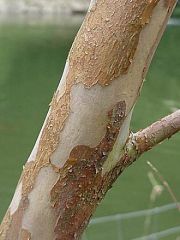
Stewartia pseudocamellia
|
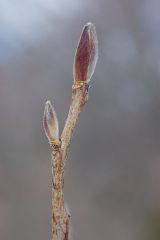
Japanese stewartia
|
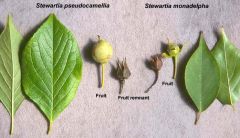
flattened, divergent buds
young stems zig-zag exfoliating bark persistent pointed capsules white camellia-like blooms in summer |
|
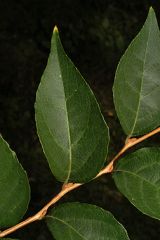
Styrax japonicus
|

Japanese snowbell
|
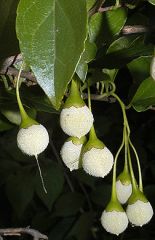
Leaf: Alternate, simple, elliptical to ovate, finely or sparsely serrated, 2 to 4 inches long, lustrous, green above, slightly paler below.
Flower: White (or light pink), 3/4 inch wide, yellow stamens, bell-shaped, five lobed, hanging from a green stalk, appearing in May to June. Fruit: Egg-shaped or round drupe, 1/2 inch long, grayish green, maturing in late summer and persisting to fall. Twig: Slender, gray to reddish brown to light brown, zigzag, scruffy, naked scruffy buds, no true end bud. Bark: Smooth, gray-brown becoming orange-brown, fissured, attractive with age. |
|
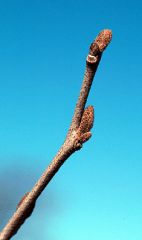
Styrax japonicus
|

Japanese snowbell
|
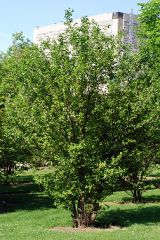
|
|
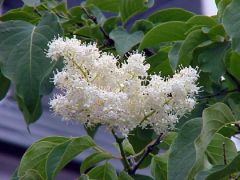
Syringa reticulata
|
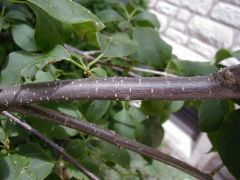
Japanese tree lilac
|
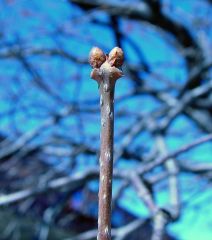
always white flowers in large panicles
very large panicles of fruit capsules opposite leaf arrangement shiny brown stems with horizontal lenticels buds have 4 pairs of scales and are brown and sessile |
|
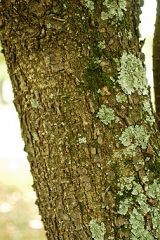
Syringa reticulata
|
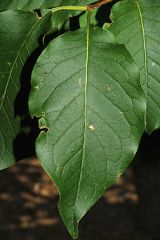
Japanese tree lilac
|
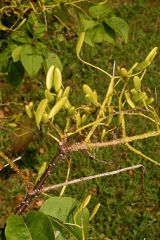
Leaf: Opposite, simple, elliptical to broadly ovate, entire, 2 to 4 inches long, dull, dark green above, lighter below with occasional slight pubescence.
Flower: Very showy, white, clustered in large terminal panicles, 4 to 12 inches long, almost equal width, appearing in late spring or early summer. Fruit: Brown capsule 1/2 to 1 long, curved, dehiscent, borne in loose clusters. Twig: Stout, shiny brown, clearly defined horizontal lenticels, glabrous; buds are large, ovate, orange-brown scales. Bark: Cherry-like, reddish brown to brown on young and old stems, horizontal lenticels remain prominent. |
|
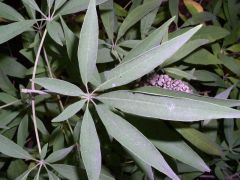
Vitex agnus-castus
|
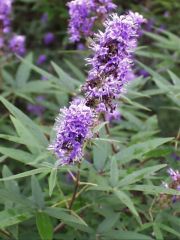
chaste tree
|
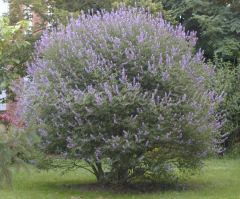
Open; irregular to rounded large shrub or small tree
Flower/Fruit: Lilac, pale violet, white flowers on 6 to 10" racemes in summer Foliage: Opposite, compound palmate dark gray-green leaves; 5 to 7 leaflets; aromatic |
|
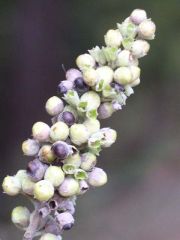
Vitex agnus-castus
|
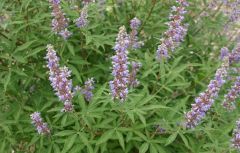
chaste tree
|
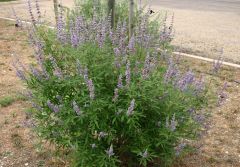
The leaves are 3-4 in (7.6-10 cm) in diameter and palmately compound with 5 to 7 fingerlike leaflets. Also called sage tree, the foliage is likewise aromatic and is typically grey-green to dark green above and lighter on the undersides. The leaves also bear a striking resemblance to those of the infamous marijuana or hemp (Cannabis spp.) plant which provides yet another common name, hemp tree. When in bloom, due to the similarity of the flowers, the chaste tree is sometimes mistaken for butterfly bush (Buddleia). The chaste tree is a sprawling plant that grows 10-20 ft (3-6 m) and about as wide. Branched flower clusters are produced on new wood in late spring and early summer in a great flush that makes the tree look like a hazy purple cloud. It continues to bloom sporadically until early fall. Not only is the tree strikingly beautiful when in full bloom, but it is also fragrant and attracts pollinating bees and hummingbirds make hungry visits. Flowers are followed by a fleshy fruit that contains four seeds that are sometimes used as seasoning, similar to black pepper (monk's pepper is another of this species' common names). Flower color ranges from violet to blue to deep purple. There is also a white form but to me they look dingy and uninteresting compared to their showier kin.
|

